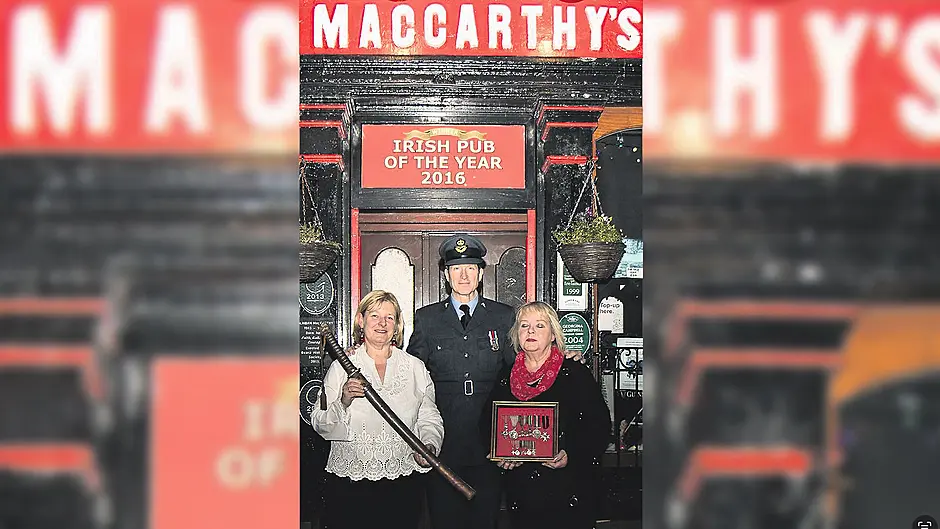An extract from a new book which charts the contributions of Irish doctors in WWII features the story of one of West Cork’s most admired medics, Dr Aidan MacCarthy from Castletownbere
DR Aidan MacCarthy from Castletownbere qualified from UCC at the end of 1938. In common with many of his fellow medical graduates he moved to England in search of medical work and acted as a locum in general practice.
By the outbreak of hostilities MacCarthy had joined the medical wing of the RAF on a short service commission. In December 1939, he was posted to France until the German advance Europe in May 1940. He was evacuated from Dunkirk along with the other 380,000 British and French troops who managed to escape.
In July 1940, Aidan MacCarthy was assigned as squadron leader at RAF Honington, a bomber command station on the Norfolk/Suffolk coast. Dr McCarthy was awarded the GM by King George IV at Buckingham Palace, the highest award for bravery in the British, citing his actions in rescuing trapped airmen when a returning bomber crash-landed at Honington base.
In December 1941, MacCarthy was appointed senior medical officer and was due to be in North Africa but was redirected to the Far East for the defence of Singapore following the Japanese invasion of Malaya.
MacCarthy’s boat did not reach Singapore before it fell in February 1942. Instead, his convoy was diverted to the port of Batavia (now Jakarta) in Java, Indonesia. Java fell to the Japanese in March 1941 and the 27 serving Allied doctors, of whom 19 were Irish, became POWs. MacCarthy was initially interred in on Java, until May 1944, when he was transported to mainland Japan.
The US fleet was active in the Pacific and on 24 June 1944, as the ship carrying MacCarthy, the Tamahoku Maru, approached mainland Japan, the American submarine USS Tang attacked the convoy, unaware that some of the ships were carrying POWs in their holds.
The POW survivors from the shipwreck were eventually picked up by a passing fleet of whaling boats. The POWs were incarcerated in Camp Fukuoka 14B in Nagasaki where they were forced to work in the Mitsubishi Corporation shipyard until the end of the war.
By the autumn of 1944, MacCarthy found himself the senior ranking officer in POW camp 14B. From then, McCarthy received the same punishment as each offender because they were his responsibility. Unfortunately for MacCarthy, his name sounded the same to Japanese ears as General Douglas MacArthur, commander of the US Pacific forces. The daily beatings received for this took their toll years later when he developed headaches and was thought to have a brain tumour. In fact, it turned out to be a benign brain cyst.
Amazingly, Aidan MacCarthy survived yet another explosion when the US air force dropped an atomic bomb onto Nagasaki on 9 August 1945. Anyone within 1km of the blast was killed instantly or in the minutes after. MacCarthy and the rest of the POWs at 14B survived because they were underground and around 1.6km from the epicentre of the explosion. MacCarthy, in A Doctor’s War, described the moments before and after the explosion of the ‘Fat Man’ atomic bomb as follows:
A couple of POWs did not bother to go to the shelters, staying on the surface and crouching on the ground in the shadow of the barrack huts. They were gazing at the sky, watching the approaching vapour trails. One of them shouted to us that three small parachutes had dropped. Then there followed a blue flash, accompanied by a very bright magnesium-type flare which blinded them. Then came a frighteningly loud but rather flat explosion which was followed by a blast of hot air. An Australian POW stuck his head out of the shelter opening, looked around and ducked back in, his face expressing incredulity. This brought the rest of us scrambling to our feet and a panic rush to the exits. The sight that greeted us halted us in our tracks. As we slowly surveyed the scene around us, we became aware that the camp had to all intents and purposes disappeared. Mostly of wooden construction, the wood had carbonized and turned to ashes. Bodies lay everywhere. People still on their feet ran in circles, hands pressed to their blinded eyes or holding the flesh that hung in tatters from their faces or arms. But most frightening of all was the lack of sunlight – in contrast to the bright August sunshine that we had left a few minutes earlier, there was now a kind of twilight. We all genuinely thought, for some time, that this was the end of the world.
In 1948 MacCarthy married Kathleen Wall and was awarded the OBE for his medical work in the POW camps. He retired from the RAF in 1971, having attained the rank of air commodore, the highest rank attainable by non-combat personnel.
Dr Aidan MacCarthy OBE, GM, MB, BCh, BAL, Knight of Sylvester, Air Commodore RAF (retired), died in 1995 and is buried in Castletownbere, where his grandfather had started MacCarthy’s General Supply Store, which eventually became MacCarthy’s Grocery and Bar. The high regard in which he is still held by the RAF is demonstrated by the fact that a new medical facility opened in 2017 at RAF Honington is named after him.

Irish Doctors in the Second World War by Patrick J Casey, Kevin T Cullen and Joe P Duignan (hardback, €29.99) is published by Merrion Press.










